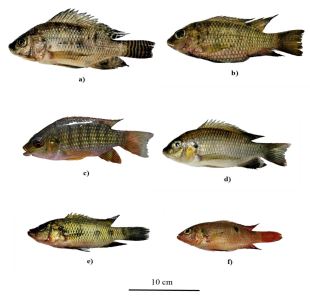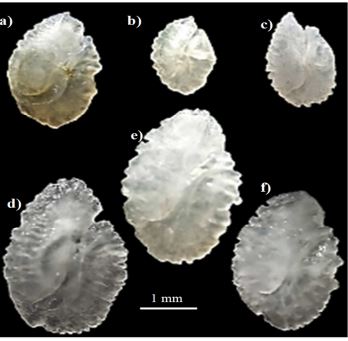N’Dri Olga Rosemonde , Monney Attoubé Ida, Attoungbre Kouakou Séverin, and Koné Tidiani, from the different institute of
the Côte d'Ivoire. wrote a research article about, Otolith Morphology of
Cichlidae Species in Lake Buyo, Côte d’Ivoire. entitled, Otolith morphology of
six species of Cichlidae from Lake Buyo in the South-west of Côte d’Ivoire. This
research paper published by the International Journal of Biosciences (IJB). an
open access scholarly research journal on Biosciences. under the
affiliation of the International Network For Natural Sciences |
NNSpub. an open access multidisciplinary research journal publisher.
Abstract
The morphology of otoliths is used as an indicator of various ecological processes or properties. So the present study was aimed to provide baseline data on the morphology of otoliths in six species of Cichlidae. A total of 179 individuals belonging to six species of the Cichlidae fished in Lake Buyo in June 2021 by artisanal fisheries. The sagitta of these species studied present common morphological characteristics. Indeed, they are elliptical in shape and robust with a concave internal face and a convex external face. However, there are a few differences that help distinguish each species. In the relationships between the total length of the fish and the length of the otolith, the values of the allometry coefficient “a” are between 0 and 1 (0 ˂ a ˂ 1) for all the species considered; they reflect a lowering allometry between the length of the fish and the length of the otolith. The values of the coefficient of determination are very high in Sarotherodon melanotheron (r2 = 0.8961), Oreochromis niloticus (r2 = 0.8469) and Coptodon zillii (r2 = 0.8403). These values reflect a strong correlation between the total length of the fish and the length of the otolith of each species. Our study, in the Ivorian or West African context, has the advantage of providing, on the one hand, morphological data on the otoliths of freshwater fish and, on the other hand, means of estimating the size of fish at from those of the otoliths.
Read more : Analyzing Drought Tolerance in Indian Chickpea Varieties | InformativeBD
Introduction
Fish provides an accessible source of nutritious food and protein for a large portion of the world's population. In Africa, among all ingested protein sources, fish and seafood occupy fourth place, after cereals, legumes and milk (FAO, 2016). However, in developing countries, the late 1990s marked the beginning of the decline in overall catches in continental waters (FAO, 2002). It is currently accepted that fishery resources are not inexhaustible (Jamet and Lagoin, 1981). Thus, supplying populations constitutes a real challenge for governments, especially at a time when consumers are increasingly interested in the quality of their food, given the increasing pollution of aquatic environments. In such a context, it appears important to sustainably manage fish stocks and this necessarily requires better knowledge of the biology and ecology of fish.
The study of fish biology can
concern certain organs such as otoliths which provide important information on
the species concerned (Panfili et al., 1990). Otolith morphology is used to
indicate various ecological processes or properties (Campana and Casselman,
1993). Like other biological structures, otolith morphology exhibits
interspecific variability. Indeed, otoliths have a distinctive shape, often
characteristic of the fish species to which they belong (Veen et al., 2005).
This is why hydrobiologists, as well as taxonomists and archaeologists, often
rely on the shape and size of preserved or undigested otoliths to determine
which species and sizes of fish were eaten by predators (Olsson and North,
1997). The relationships between the otolith and the fish have been studied by
several authors (Echeveria, 1987; Campana et al., 1993; Aydin et al., 2004 and
Veen et al., 2005). Also, some researchers have succeeded in measuring the
duration of the reproductive cycle of fish (Seret and Opic, 2011) and
calculating their age (Panfili et al., 1990) using the otolith.
In Ivory Coast, most of the studies carried out in ichthyology have made it possible to understand the biodiversity of fish (Kamelan, 2014), their food ecology (Kouamélan, 1999), their reproduction (Koné, 2000) as well as their reproduction areas (N'Dri, 2020). However, the field of otolithology remains little explored. So far, the work carried out only concerns fish otoliths from the West African coasts (Veen and Hoedemakers (2005), and few data exist on freshwater fish. In these continental waters, the Cichlidae family is part of the most represented families. It constitutes, for example, 35% of the catches of fishermen from Lake Buyo; with more than eight species (N'Dri et al., 2020; Goli, 2021). Thus, given the combined effect of overexploitation and climate change which threatens the breeding areas of cichlids, which could lead to the disappearance of certain species (Yao et al., 2023), it appears necessary to describe their otoliths in order to archive them. The general objective of this study is therefore to determine the morphological and morphometric data of the otoliths of six species of Cichlids captured in Lake Buyo. This will firstly involve describing the morphology of the otoliths of the species collected and secondly studying the relationships between the size of the fish and that of its otolith.
Reference
Anonyme. 1999.
Diversité biologique de la Côte d’Ivoire. Rapport de synthèse du Ministère de
l’environnement et de la Forêt 273, 105-106.
Aydin R, Calta M, Sen
D, Coban MZ. 2004. Relationships between fish lengths and otolith length
in the population of Chondrostoma regium (Heckel, 1843) inhabiting
Keban Dam Lake. Pakistan Journal of Biological Sciences 7, 1550- 1553.
Beamish RJ, McFarlen GA.
1987. Current trends in age determination methodology. In: Age and growth of
fish (Summerfelt R. C. and Hall G. E., Eds.). Iowa State University Press,
15-42.
Campana SE Casselman
JM. 1993. Stock discrimination using otolith shape analysis. Canadian
Journal of Fisheries and Aquatic Sciences 50, 1062-1083.
Casselman JM. 1990.
Growth and relative size of calcified structures of fish Transaction of the
American. Fisherie Society 119, 673-688.
Chaine J, Duvergier J. 1934.
Recherches sur les otolithes des poissons. Etude descriptive et comparative de
la sagitta des Téléostéens. Actes de la Société Linnéenne Bordeaux 86,
5-254.
Echeveria TW. 1987.
Relationship of otolith length to total length in rockfishes from northern and
central California. Fishery bulletin 85, 383-387.
FAO. 2002. Deficit
irrigation practices. FAO Water Reports 22, 111 p.
FAO. 2016. La
situation mondiale des pêches et de l’aquaculture 2016. Contribuer à la
sécurité alimentaire et à la nutrition de tous, Rome 224 p.
Geldiay R, Balık S. 1996.
Türkiye Tatlısu Balıkları. Ege Ünv. Fen Fak. Kitaplar Serisi, Ege Ünv. Basımevi
İzmir 97, 519 pp.
Goli BBEP. 2021. Pêche
et analyse socio-économique de l’exploitation halieutique du lac de barrage de
Buyo (fleuve Sassandra, Côte D’Ivoire). Thèse de Doctorat, Université Félix
Houphouët Boigny Côte d’Ivoire 219 p.
Hattour A. 2009.
Les thons mineurs tunisiens: Etudes biologiques et pêche. Collection volume.
Science Papers ICCAT 64 (7), 2230-2271.
Hunt JJ. 1979.
Back-Calculation of length at age from otoliths for silver hake of the Scotia
Shelf. ICNAF Sel Papers 5, 11-17.
Jamet J, Lagoin Y.
1981. Manuel des pêches maritimes tropicales. Tome 1, SCET, 447 p.
Kamelan TM. 2014.
Peuplement ichtyologique de quelques hydrosystèmes de l’espace Taï (Côte
d’Ivoire). Thèse de Doctorat, Université Félix Houphouët-Boigny (Abidjan, Côte
d’Ivoire) 276 p.
Koné T. 2000.
Régime alimentaire et reproduction d’un tilapia lagunaire (Sarotherodon
melanotheron Rüppell, 1852) dans la rivière Bia et le lac de barrage d’Ayamé
(Côte d’Ivoire). Thèse de Doctorat, Katholieke Universiteit Leuven,
Belgique 253 p.
Kouamélan EP. 1999.
L’effet du lac de barrage Ayamé (Côte d’Ivoire) sur la distribution et
l’écologie alimentaire des poissons Mormyridae (Teleostei, Osteoglossiformes).
Thèse de Doctorat, Katholieke Universiteit Leuven, Belgique 221 p.
N’Dri OR. 2020.
Identification et caractérisation des frayères à poissons dans le lac de
barrage de Buyo (Côte d’Ivoire). Thèse de Doctorat, Université Jean Lorougnon
Guédé (Daloa, Côte d’Ivoire) 156 p.
N’Dri OR, Konan YA,
Bamba M, Monney AI, Koné T. 2020. Length-weight relationships and
condition factor of twenty-four freshwater fish species from lake Buyo, Côte
D’Ivoire. Journal of Fisheries and Aquatic Science 15, 27-34.
Nielsen JR, Methven DA,
Kristensen K. 2010. A statistical discrimination method using sagittal
otolith dimensions between sibling species of juvenile cod Gadus morhua and Gadus
ogac from the Northwest Atlantic. Journal of Northwest Atlantic Fishery
Science 43, 27-45.
Olsson M, North. 1997.
Ontogenetic niche shifts in largemouth bass: Variability and consequences for
first-year growth. Ecology 77, 179–190.
Panfili J, Ximénès MC,
Do-Chi T. 1990. Age determination of eels in the French Mediterranean
lagoons using classical methods and an image analysis system. International
Revue der gesamtem Hydrobiologie 75, 745-754.
Panfili J, De-Pontual
H, Troadec H, Wright PJ. 2002. Manual of Fish Sclerochronology. Published
by IFREMER-IRD (Brest, France) 463 p.
Paugy D, Lévêque C,
Teugels GG. 2003a. Faune des poissons d’eaux douces et saumâtres de
l’Afrique de l’Ouest, Tome I. Editions IRD (Paris), MNHN (Paris), MRAC
(Tervuren) 457 p.
Paugy D, Lévêque C,
Teugels GG. 2003b. Faune des poissons d’eaux douces et saumâtres de
l’Afrique de l’Ouest, Tome II. Éditions IRD (Paris), MNHN (Paris), MRAC
(Tervuren) 815 p.
Paxton JR. 2000.
Fish otoliths, do sizes correlate with taxonomic group, habitat and/or
luminescence? Philosophical Transactions of the Royal Society of London
Biological Sciences 355, 1299-1303.
Popper AN, Luz ZM. 2000.
Scrucrure-funcrion relarionships in fish orolirh organs. Fisheries RfJfarch 46,
15-25.
Ramcharitar J, Higgs
DM, Popper AN. 2001. Sciaenid inner ears: A study in diversity. Brain
Behavior and Evolution 58, 152-162.
Rhodes KL, Joseph E,
Mathias D, Malakai S, Kostka W, David D. 2005. Reef fish spawning
aggregation monitoring in Pohnpei, Federated States of Micronesia, in response
to local management needs. SPC Live Reef Fish Information Bulletin 5, 20-24.
Sallami B, Béarez P,
Ben-Salem M. 2013. Relations allométriques entre la longueur du poisson et
la taille de l’otolithe chez trois anguilliformes des côtes du nord de la
Tunisie (Méditerrané centrale). Cybium 37 (3), 159-163.
Secor DH, Dean JM,
Laban EH. 1991. Manual for otolith removal and preparation for
microstructure examination. Baruch Institute Technical Report 91-1, University
South Carolina, Columbia, SC 85 p.
Seret B, Opic P. 2011.
Poissons de mer de l’ouest africain tropical. ORSTOM 1981, IRD Éditions
Marseille 451 p.
Traoré K. 1989.
Caractéristique bio-écologique du peuplement ichtyologique du lac de Buyo.
Rapport de Recherche, Institut d’Écologie Tropicale (IET), Côte d’Ivoire 182
p.
Tuset VM, Lombarte A,
Gonzaley JA., Pertusa JF, Lorente MJ. 2003. Comparative morphology of the
sagittal otolith in Serranus spp. Journal of Fish Biology 63, 1491-1504.
Tuset VM, Lombarte A,
Assis CA. 2008. Otolith atlas for the western Mediterranean, north and
central eastern Atlantic. Scientia Marina 72S1, 7-198.
Veen J, Petters J,
Leopold MF, Van Damme CJG, Veen T. 2003. Les oiseaux piscivores comme
indicateurs de la qualité de l’environnement marin: suivi des effets de la
pêche littorale en Afrique du Nord-Ouest. Wageningen, the Netherlands, Alterra
Rapport 666, 190 p.
Veen J, Hoedemakers K. 2005.
Synopsis iconographique des otolithes de quelques espèces de poissons des côtes
ouest africaines. Based on otolith microstructures in Tilapias (Pisces,
Cichlidae). Fishery Bulletin 99, 139-15.
Yao KA, N’Dri OR, Bodji
IM, N’Zi KG, Koné T. 2023. Buyo hydroelectric dam, Côte d’Ivoire: what impact
on ichthyological spawning grounds? American Journal of Environmental
Protection 11 (1), 1–6.












%20in%20full.JPG)


0 comments:
Post a Comment